Automated Critical Updates is a new feature that allows you to configure scheduled security updates. It is activated by default on firmware 9.0.0. The feature runs on Control Centers and both managed and stand-alone firewalls. Running the feature on the box level of a Control Center is the same as running the feature on a stand-alone firewall.
When Barracuda Networks provides a security update, the related file becomes available on the Barracuda Download Portal. The Automated Critical Updates feature automates the manual steps for selecting these files to maximize security and for downloading them to the Control Center or a stand-alone firewall based on the configured time frames for the installation.
The window for firmware updates also displays the availability and the status of automated critical updates in two views at CONTROL > Firmware Updates:
Top view – The upper half of the view shows the status of the security updates in the column Initiated by the entry Automatic.
Lower-left view – The lower-left view contains one or more entries that contain the label SECURITY in the column SCOPE.
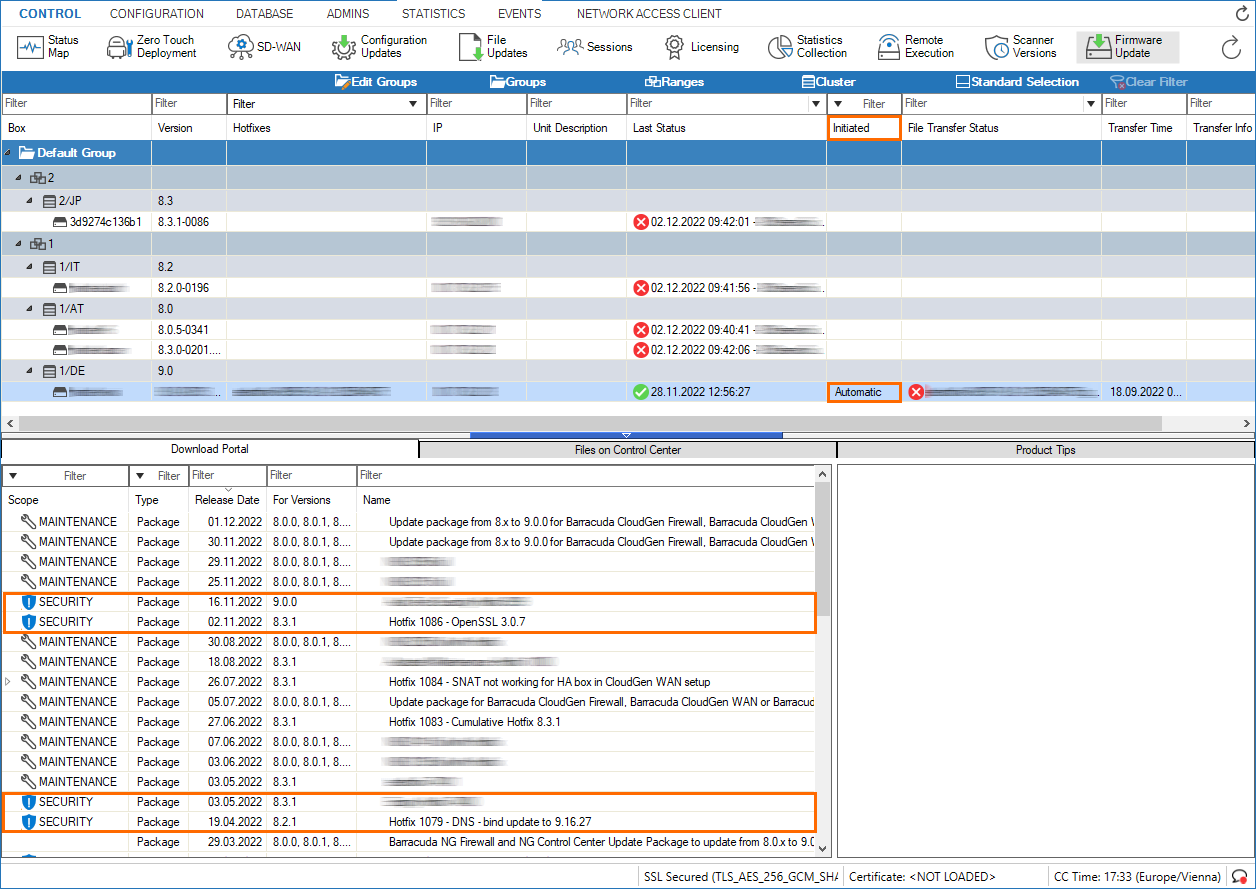
You can still inspect the status and stop updates in the Schedule view.
Notification of Activated Feature upon Login
Because automated critical updates are activated by default on firmware 9.0.0, you will see a notification window upon your first login informing you that the feature is already running and where to configure the feature depending on the type of your appliance. The timeframe in which automated critical updates take place is preset from 1:00 AM to 3:00 AM. You can deactivate this dialog notification window by selecting the check box in the lower-left corner.
Note the different announcements in the dialog window that refer to the related configuration node on each of these three different instances:
Notification on a Control Center | Notification on a Managed Firewall | Notification on a Standalone Firewall / CC Box Level |
|---|---|---|
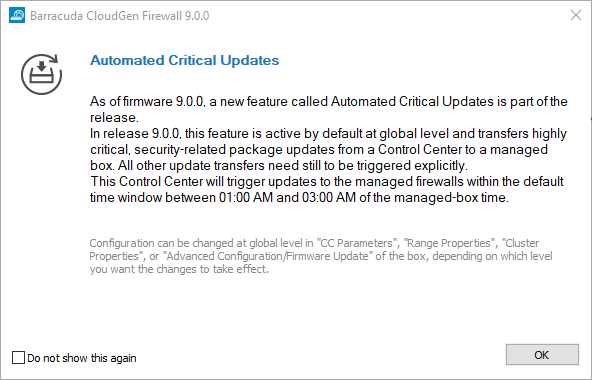 | 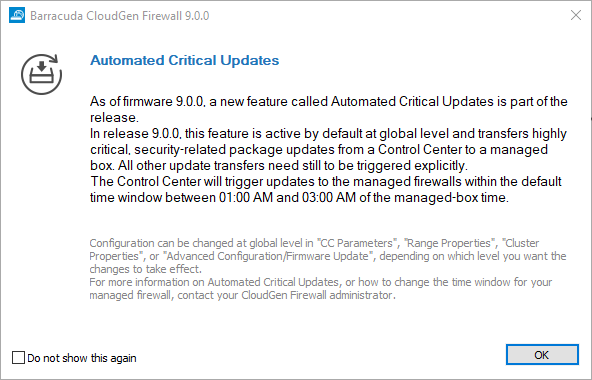 | 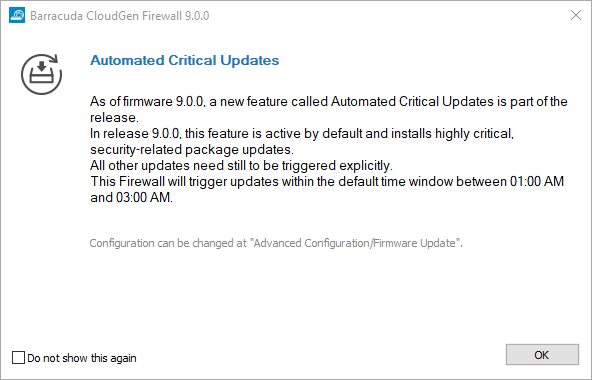 |
|
|
|
For security reasons, Barracuda Networks recommends keeping the feature activated. However, if you do not want to use it, you can deactivate it at the corresponding node in the configuration tree.
Configuration of Automated Critical Updates
The configuration of automated critical updates is preset for all relevant parameters in the configuration window. However, the node for this configuration window varies depending on what appliance the configuration has to be made on.
Configuration Node on a Control Center | Configuration Node on a Managed Firewall | Configuration Node on a Stand-alone Firewall / CC Box Level |
|---|---|---|
| CONFIGURATION > Configuration Tree > Box > Advanced Configuration > Firmware Update
| CONFIGURATION > Configuration Tree > Box > Advanced Configuration > Firmware Update |
Apart from Control Center-specific services, a Control Center is basically a stand-alone firewall at the box level and therefore has the same configuration nodes in the configuration tree as a stand-alone firewall. For this reason, the configuration node Firmware Update is the same for each of them. On managed firewalls, however, you will see a warning dialog window informing you that the configuration is managed by a related Control Center if you make an attempt to lock the node for modification.
Also, because a managed firewall is subordinated to its related Control Center, its settings for firmware updates depend on whether the configuration is related to a specific cluster or range. The managed firewall will therefore receive the configuration that contains the schedule for updates from the settings configured either at the global, range, or cluster level. In addition, these settings can also be overridden as described below.
Time Frames and Schedule
Time frames are essential for performing automated critical updates on any firewall / Control Center. Because the beginning of a time frame indicates when exactly the Control Center must check the availability of new security updates, the effective update time can be delayed.
A time frame is defined by the beginning and end time, and can be configured individually. For the purpose of automated critical updates, the following parameters must be configured:
From (Day) – The day of the week (Mon, Tue, ...)
From (Time) – Time stamp in 24h format
To (Day) – The day of the week (Mon, Tue, ...)
To (Time) – Time stamp in 24h format
You can enter multiple time frames. A time frame may exceed a single day. If time frames overlap, they are regarded as single, connected time frame. The following image shows two time frames that overlap. The effective time frame therefore begins on Saturday at 22:00, and ends on Sunday at 01:00. All three time frames together build a schedule.

A schedule for automated critical updates may be configured both on stand-alone firewalls and on the box level of Control Centers, and on the CC levels of Global, Range, and Cluster.
Automated Security Update Schedules on a Stand-alone Firewall and on Box Level of a Control Center
On a stand-alone firewall or on the box level of a Control Center, you can configure a schedule for automated critical updates at CONFIGURATION > Configuration Tree > Box > Advanced Configuration > Firmware Update. The schedule in the following image also shows the standard preset configuration.
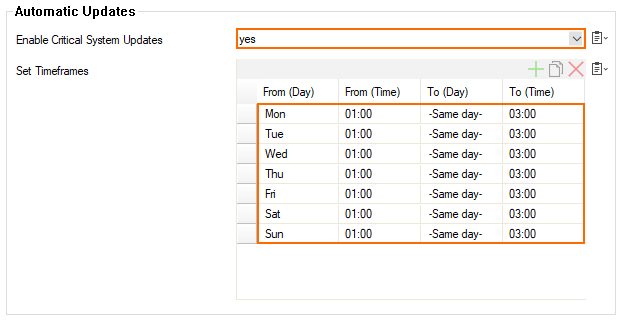
To use the feature, select yes for Enable Critical System Updates. The firewall will then contact the update server and download the security updates if there are any present.
Automated Critical Updates for an On-Premise HA-Pair of Firewalls
If a scheduled entry triggers an update for an on-premise HA box, the procedure is as follows:
The secondary must be updated first.
1a. If the update on the secondary was not successful, a new attempt must be made.The primary can only be updated after a successful update of the secondary.
The following flowchart makes this process more transparent:
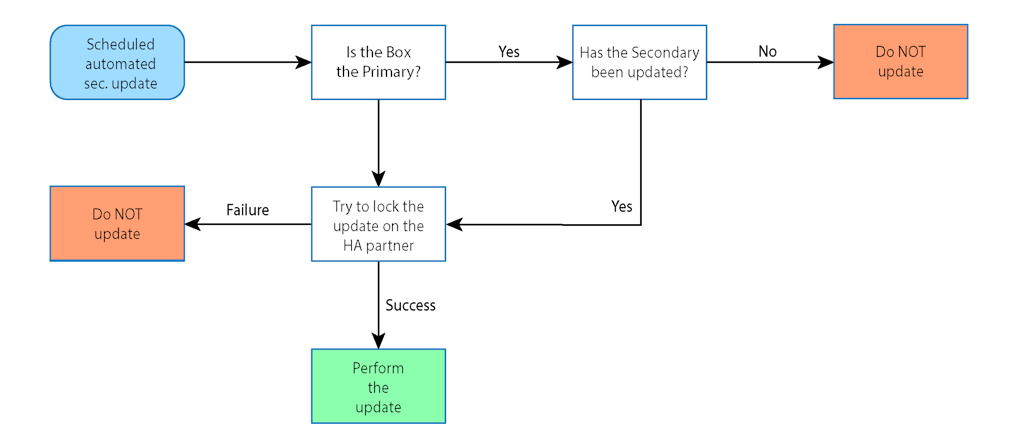
Inherited, Push, or Pull – How the Control Center Uses Metadata to Control Automated Critical Updates for Managed Firewalls
Metadata is data that provides basic information about certain content without any content details. For automated critical updates, this means that metadata contains information about the availability of certain update files and where they can be found but not the update file itself.
Because the Control Center handles settings on the global, range, and cluster levels, the settings for automated critical updates are present on all three configuration levels at the nodes, as listed in the table above. In order to configure the feature with maximum flexibility for all managed firewalls, you have the option of inheriting the settings from the global level to the range level and from the range level to the cluster level. To do so, select the third option from the menu list for the mode: Inherited.
As a consequence, the Control Center handles automated critical updates in three different ways. These three Mode options are named in the user interface as shown in the table below. You can decide which mode best matches your requirements:
Mode | Meaning | Note |
|---|---|---|
Inherited | Ignore the following two options and apply the configuration settings of the parent configuration level. | This option does not apply to the global level in the configuration tree and is only available on the range and cluster levels. |
CC Push | The Control Center downloads all available security update files from the download portal locally and sends them to the managed firewall according to the schedule of its own configuration level. | The Control Center must be permanently available for the managed appliances. If the connection gets interrupted, the managed appliances cannot be updated. Pros:
Cons:
|
Box Pull | The managed firewall receives the metadata from the managing Control Center and downloads the security update files from the download portal according to the locally configured schedule. This mode overrides any preset that is propagated from a higher configuration level in the configuration tree of the Control Center and takes the schedule from its own configuration level. Schedules from the range or cluster level are ignored.
| Temporary disconnections of the managed firewalls from the Control Center will not prevent the firewalls from downloading updates provided that the firewalls do not lose their connection to the update servers. Pros:
Cons:
|
From the list, select the Mode that best fits your requirements.

The following table shows which configured values will be relevant for managed boxes depending on the Mode option at each corresponding level in the configuration tree:
Config Level | Update Node | Mode | Preset | Meaning |
|---|---|---|---|---|
Global | CC Parameters | - |
| - |
|
| CC Push | * | Control Center sends security updates to the managed box. |
|
| Box Pull |
| Managed firewall receives metadata from the CC and downloads the security update itself according to the local schedule. |
Range | Range Properties | Inherited | * | Both CC Push settings and Box Pull settings are taken from the global settings. |
|
| CC Push |
| Control Center sends security updates to the managed box. |
|
| Box Pull |
| Managed firewall receives metadata from the CC and downloads the security update itself according to the local schedule. |
Cluster | Cluster Properties | Inherited | * | Both CC Push settings and Box Pull settings are taken from the range settings. |
|
| CC Push |
| Control Center sends security updates to the managed box. |
|
| Box Pull |
| Managed firewall receives metadata from the CC and downloads the security update itself according to the local schedule. |
Box | Firmware Update | Inherited | * | Both CC Push settings and Box Pull settings are taken from the cluster settings. |
|
| CC Push |
| Control Center sends security updates to the managed box. |
|
| Box Pull |
| Managed firewall receives metadata from the CC and downloads the security update itself according to the local schedule. |
Preset Configuration Values
The preset values for Automated Critical Updates apply only to managed firewalls and not to stand-alone firewalls:
Enable Critical System Updates – yes.
Mode
On global CC Level – CC Push.
On Range, Cluster, and Box level – Inherited.
Set Time frames – Mon - Sun, 01:00 - 03:00.
Note that the preset value of 01:00 - 03:00 has a duration of 2 hours, which is the minimum time required for performing security updates.
If you enter a time frame of less than 2 hours, a small red warning sign will appear.

CC-Managed HA Pairs
In order to not compromise the concept of HA, scheduling automated updates does consider that an HA pair will always be available. To do so, the Control Center first updates the secondary firewall and checks if the update was successful. If so, the primary firewall is then updated. If the secondary firewall encounters problems after an update, the primary firewall will not be updated in order to ensure further availability.
For more information on HA, see High Availability.
Logging, Status about Updates
The Automated Critical Updates feature sends messages to the log. These messages can be identified by the prefix auto_firmware_update and can be checked at CONFIGURATION > LOGS > Box > Release > update.
You can also get information about the status of the update log at CONTROL > Firmware Updates. Right-click your mouse on an entry of an automated update to display a list that contains the entry Show Details. Click this entry, and a window will open that shows details about the log, the versions, and the packages.
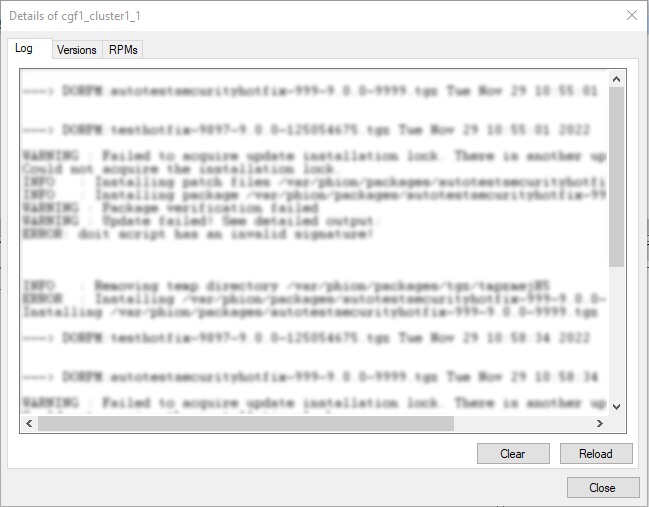
Status View for Automated Updates
You can check the state of the Automated Critical Updates feature in the Status Map on the Control Center. The column Automated Update in the following screenshot shows the status for the range level, the cluster level, and the firewall subordinated to the cluster.

